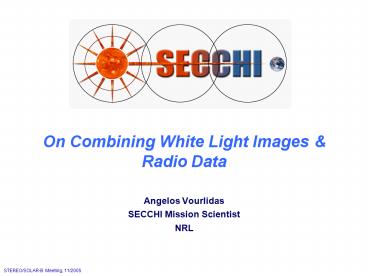On Combining White Light Images - PowerPoint PPT Presentation
Title:
On Combining White Light Images
Description:
Accurate timing of eruption initiation and development. Derivation of physical parameters in the eruptive ... ORT (327MHz) STEREO/SOLAR-B Meeting, 11/2005 ... – PowerPoint PPT presentation
Number of Views:46
Avg rating:3.0/5.0
Title: On Combining White Light Images
1
On Combining White Light Images Radio Data
- Angelos Vourlidas
- SECCHI Mission Scientist
- NRL
2
Summary
- Contributions of Radio Observations
- Accurate timing of eruption initiation and
development. - Derivation of physical parameters in the eruptive
structures (when thermal). - Positional information on Type-II (shocks)
sources. - Identification of electron acceleration sites.
- Tracking the CME evolution from birth to Earth.
- Discovery of precursors to solar eruptions.
3
Radio Type-II Emissions and CMEs
1. Type-II emissions remain unreliable proxies of
solar eruptions.
- 90 of EUV waves are associated with metric
Type-IIs (Klassen et al. 2000). - But EUV waves are better correlated to CMEs
(Biesecker et al. 2002). - Type-IIs are blast waves (30), CME-driven (30)
or behind CME (30) (Classen Aurass 2002).
2. A possible new technique for joint
Type-II/LASCO data analysis.
- Consistency between LASCO densities and Type-II
profiles can pinpoint the CME launch time,
position angle and type-II source region (Reiner
et al. 2002).
4
Radio Spectra of CMEs
1. Continuous Spectral Coverage of Radio Solar
Emissions.
Several Spectrometers (2 GHz 100 KHz)
(Dulk et al. 2000)
(Leblanc et al. 2000, 2001)
- Establish the flare/CME/Type-II temporal
relation. - Multiple Type-II sources.
- Evidence for shock-accelerated electrons.
5
Radio Imaging of CMEs
6. IPS Mapping of CMEs.
ORT (327MHz)
(Manoharan et al. 2001)
- Follow the CME evolution in IP space.
6
Radio Imaging of CMEs
4. Image directly radio CME loops for the first
time.
(Bastian et al. 2001)
- Image fine-scale CME structures.
- Derive physical parameters
BCME 0.1-few G, E 0.5-5MeV, nth 107 cm-3
7
Radio Precursors of CMEs
1. Drifting continuum sources may signal the
birth of the CME.
(Aurass et al. 1999)
2. The role of Noise Storms remains controversial.
- Some NS changes correlate with CME (Chertok et
al. 2001). - NS starts before CME (Ramesh Sundaram, 2001) or
after CME (Willson, 1998).
- More work is needed to establish reliable radio
precursors for CMES.
8
Coordination Issues
Need to add or coordinate
- With radio GBOs to provide spectra on a regular
basis (extent the S/WAVES spectrum to solar
corona). - With imaging interferometers to provide images.
- Nancay RH is already collaborating
- Gauribidanur RH should be added.
- With IPS instruments to provide continuous
coverage of IP space - EISCAT is not IP-dedicated, time allocation is a
problem - MEXART opens officially next month (12/05)
- Ooty has manpower problems?
9
Backup Slides
10
Radio Data CME Catalog
Need to add or coordinate
- More ground-based radio spectra to extent the
S/WAVES spectrum to solar corona - Gauribidanur images at 109MHz.
- CACTUS CME info
11
IPS
- Indirect maps of CME
- Possibility of continuous coverage (EISCAT?,
STEL, Ooty, MEXART) - Data complimentary to coronagraph data (Ne along
LOS, speed of solar wind)
Manoharan et al (2002)
12
Radio Imaging of CMEs
2. Identify the shock at the CME front.
(Maia et al. 2000)
3. Identify sources of Type-II (shock) emission
behind the CME front.
- Radio CME front is faint.
- Several candidates for Type-II emission can be
identified.
(Vourlidas et al. 1999)
13
Why combine radio WL images?































